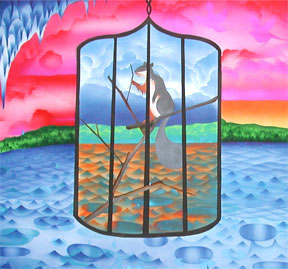Today's New York Times has an
article about the restoration of a painting of Clara, a world famous rhinoceros who toured Europe in the 1700s.

Clara, by Jean Baptiste Oudry
The painting is at the
Getty Museum, and it shows a life sized Clara looking newly dapper after languishing for years in the basement of the Staatliches Museum in Holland.

(The article mentions that the conservator wore a tie the whole time he was working on the painting.)
Clara the rhinoceros was adopted by a director of the Dutch East India Company, Jan Sichterman, when she was one month old. Clara was described as a "hideous animal of the female gender" but Sichterman, who raised her after her mother had been killed by hunters, let Clara move freely around his house- she navigated around the furniture without a problem and ate her food from a plate.
When she got too big for the house, she was sold to Douwemout Van der Meer, a 36 year old sea captain who hoped to make a living exhibiting her around the world. It's important to note that at this time- Clara was sold in 1741- the rhino was a very exotic animal.
The rhino was classed as a semi-mythological beast. In bestiaries in the 1500s it was confused with the unicorn, which was called the monocerous. People in Europe had heard of them, but weren't sure they really existed. This is the first known image of a rhino- it was published in 1515 in Lisbon, where a live rhino had arrived by ship eight weeks earlier.

Durer's famous rhino is a woodcut made in the same year from written descriptions of the Lisbon rhino, which accounts for its relative accuracy- but
check out the horn on its back.

Durer drew this rhino too- it's much more feral looking.

The horn on its back was part of the mythology about rhinos, as was the fact, promulgated by Pliny the Elder in 23 CE, that the rhino was deadly enemy of the elephant, which it was said to gore with its horn.
The Lisbon rhino from 1515 was a gift for a pope. Before he got to the pope he spent time in the menagerie of a king who happened to have an albino elephant on hand. The king wanted to test Pliny's theory, so he set the rhino and the elephant up for a showdown. The elephant, terrified, turned tail and ran. The elephant's name was Hanno.

Woodcut of Hanno on pamphlet by Philomathes (Rome, c. 1514)
The Lisbon rhino died in a shipwreck off the coast of Italy. There were other attempts to give rhinos to European royalty but the difficulty of getting them across the ocean alive made them pretty rare. If you're interested in the history of rhino migration to Europe until 1515 (I know I am!) you can check out a detailed history
here.
Clara was to become a far more successful traveler. Captain Van der Meer sailed with Clara from Calcutta to Rotterdam, keeping her skin from drying out by slathering her with fish oil and feeding her what he correctly estimated as her daily nutritional requirement of 150 pounds of vegetable matter a day. He did very well exhibiting her across Europe. Empress Maria Teresa, of the royal family of the Holy Roman Empire, was particularly fond of her private audiences with Clara.

Captain Van der Meer became Baron Van der Meer. He not only exhibited Clara, but did a swift trade in Clara souvenirs, which were proudly displayed by members of the nobility and the general public who had been fortunate enough to see Clara. Here she is in Vienna in a 1746 engraving by Elias Baeck.

One year later Mannheim made this image of Clara,
das Nashorn . Note that Clara, despite her tolerance for Empress Maria Teresa, is fiercely goring an elephant in the background. Click
here to see a bigger image.)

Poems and songs were written about Clara, french naval boats were named after her (
Rhinocéros, not Clara) and in Paris men could have their wigs styled
à la rhinocéros. She even made it into anatomy books.
 Clara the rhinoceros (1742)Engraving by Jan Wandelaar for Bernhard Siegfried Albinus' book: Tabulae sceleti et musculorum corporis humani. Printed in Leyden by James and Henry Verbeek, 1747.
Clara the rhinoceros (1742)Engraving by Jan Wandelaar for Bernhard Siegfried Albinus' book: Tabulae sceleti et musculorum corporis humani. Printed in Leyden by James and Henry Verbeek, 1747.Eventually Clara made it to Rome, where she either rubbed off her horn or it was removed. In any case it didn't stop her from being painted, this time by Pietro Longhi in 1751.

She continued to travel around Europe until she ended up in London, where she died at around 20 years old.
 Jean Goujon: Obelisk1549
Jean Goujon: Obelisk1549There's more about Clara in a recent
Chicago Sun Times Article, and I got a lot of my information from
Wikipedia. There's also a book I'm going to have to get,
Clara's Grand Tour, by Glynis Ridley. While I was researching Clara I came across another famous rhino,
Cornelius the first, who ran for a seat in the Canadian House of Commons in 1965. If anyone can tell me more about Cornelius I'll be very happy.
